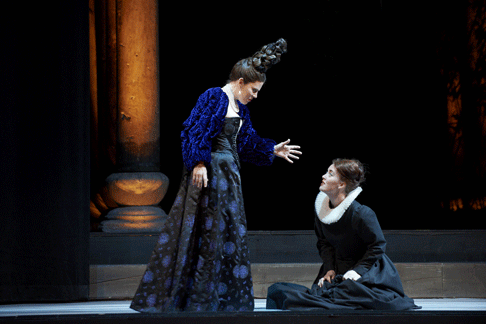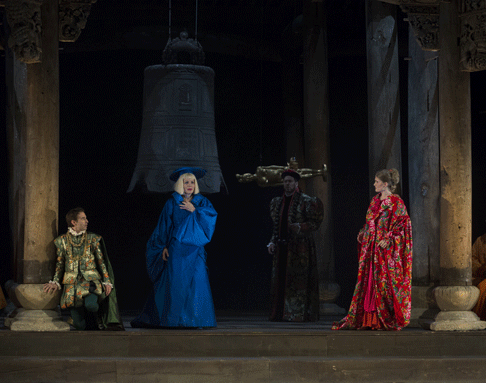21 May 2012
Semele, Canadian Opera Company
You never can tell. I would never have predicted which opera would be my favourite of the seven operas programmed this season by the Canadian Opera Company.

You never can tell. I would never have predicted which opera would be my favourite of the seven operas programmed this season by the Canadian Opera Company.
Both the adventurous staging and the consistently brilliant singing make Handel’s Semele by far the best opera production I’ve seen from the COC.
Luckily I had my backstage preview of the opera that gave me a chance to wrap my head around this most original approach to Semele in the piece I posted a few days ago. My expectations were confirmed, the production doing pretty much what I’d expected. I had wondered if the COC would allow the liberties with Handel that (director) Zhang Huan took in the two previous incarnations (in Belgium & later China). They did indeed.
I am going to explain where I am coming from. Opera purists who come to a performance expecting -or demanding—that the usual procedures be followed might take issue with this production, as they have in New York with the Lepage Ring cycle. Just as Lepage strove to get back to the original text -albeit via an expensive modern production—so it would appear do Zhang.and his team.
But how, you may wonder, can a production using a dancing horse, a Tibetan singer, sumo wrestlers, puppets and finishing with a version of the Internationale, be in any sense faithful? I think the problem is in how we understand the work.
Semele began as a Lenten oratorio, making it a bit of an oxymoron if one considers that this erotically charged work was fashioned to premiere in the season of restraint. It’s in the most curious balance between the rational and the passionate, frequently stepping back to make detached commentaries about its action through its chorus, then giving one of the principals the opportunity to explore their feelings. The schizophrenic push-me pull-you style of baroque oratorio (or opera) is hyper-repressive, in the way that action moves in discreet chunks, followed by a lengthy exploration of a passion in the stasis of an aria. To a Martian -or come to think of it, a Chinese installation artist such as Zhang—Handel’s oratorio would seem very odd. It doesn’t really have a native performance style, having been uprooted from the beginning, in the almost immediate rejection of this style by the London public, a kind of exile that’s never really had a proper home, but was always something of a fish out of water. The worst thing one could do is stage it as though it were realistic, as some have attempted.
In the 18th century, opera was a very different experience from what we get now. If you had Juno & Semele onstage together they would both be dressed in lovely attire, but without any clear indication what century they were to portray, let alone the kind of precisely coded costuming and set one frequently encounters nowadays. I believe that were a baroque performer suddenly resurrected in Toronto and shown the three operatic programs currently being staged, they’d find Zhang’s approach - where the set is merely a context rather than an attempt to simulate a world—highly congenial and recognizable, while feeling a bit odd on a set from a specific time (as you find in Gianni Schicchi or Contes d’hoffmann). I believe this production is far more congenial to the work than the conventional / purely representational approaches.
 (l - r) Allyson McHardy as Juno and Katherine Whyte as Iris
(l - r) Allyson McHardy as Juno and Katherine Whyte as Iris
That Zhang chose to substitute parts of the opera might also upset purists, but in the 18th century it was the way opera was done. I’m not saying Zhang read about suitcase arias, but I applaud his choices on the grounds that any purist defending Handel on grounds of textual integrity needs to remember that such principles are always relative to the century you’re working in.
Sigh. I did run into a couple in the elevator who left at the intermission. Of course I was grinning like a 5 year old and said “how did you like it,” not expecting that anyone felt different than I did (and the house had erupted in applause at the end). When I talked to them they were pleasant but seemed mystified by the production, which mixes serious (a 450 year old Buddhist temple, a tale of gods and mortals) and silly (an inflatable puppet, a dancing horse, sumo wrestlers), and couldn’t understand my enthusiasm, which I was unable to conceal.
For me, Zhang’s production feels like a production from first principles, addressing fundamental questions about what it is to be human or immortal, to be incarnated in a body or concealed in another form (and this is true of both of the gods as well as the temple that is the set). Those thoughtful arias and choruses that seem too rational for real life make sense in this inter-life place, a temple where souls come to be incarnated, or comment afterwards (as Semele does). The odd mix of styles and cultures-of Handel in English, a Tibetan song, a pair of sumo wrestlers, and to finish, the Internationale—are properly multi-cultural, as if in a magical place that is all cultures and no cultures, a forgiving mix that is a reflection of this oddball opera.
In a more typical production of Semele I’d be feeling a bit strange about Juno, Jupiter and Semele, who would look like opera singers onstage, even though one purports to be mortal, while the other two are supposedly gods. If, however, we’re in this odd space suggesting souls seeking peace, the abstract conversation makes much more sense. I no longer mind that a god and a mortal are side by side, because they’re in a virtual space for the incarnation of souls, as we might see for example in Noh theatre.
This is the most sensual opera I have ever seen. There’s more touching, more allusions to sexuality, more pure passion than I’ve ever seen in a production of Tristan und Isolde (Wagner lovers take note). The chorus were often pressed into service as if they were illustrations in a sex-ed textbook, or failing that, used for their voyeuristic potential when Jupiter & Semele were at it.
Tenor William Burden was a very believable Jupiter, singing the opera’s best known tune, “Where e’er ye walk”, a concretely sensual exploration of Semele, massaging and washing the feet of Jane Archibald as she lay on her back before him. Elsewhere, his cadenzas were opportunities to teasingly manhandle her, the god bewildering her with his physical dominance.
Semele is also very funny. Juno is jealous of Semele, and because we’re seeing a production unafraid of the text, the humour is very close to the surface. Allyson McHardy has no remorse leading Semele to her doom, gleefully celebrating. The voice reminds me of Janet Baker, with consistent richness well below middle C, and wonderful musicianship. I would have been happy had she been the star, thrilled by her singing.
 (l - r) Anthony Roth Costanzo as Athamas, Allyson McHardy as Ino, Steven Humes as Cadmus and Jane Archibald as Semele
(l - r) Anthony Roth Costanzo as Athamas, Allyson McHardy as Ino, Steven Humes as Cadmus and Jane Archibald as Semele
The cast is one of the strongest seen at the Four Seasons Centre in recent years, with no weaknesses, Semele was especially strong, as played by Jane Archibald. There are several arias that stop the show, particularly the third act aria “My self I shall adore”. A disguised Juno presents Semele with a mirror that makes her ever more vain & self-loving. The set design made the entire stage a colossal mirror, reflecting the theatre back to itself. Archibald coyly played to this huge mirror, never seeming at all taxed in this most difficult of arias. I suddenly remembered: they premiered the opera two nights ago, yet Archibald was singing effortlessly, popping out what sounded like a high F above a couple of Cs in that aria, a D in another aria, and showing several different types of singing. Archibald all by herself is actually better than any opera presented this season, perhaps the best coloratura in the world right now, a gorgeous, witty actress playing the part with such complete ease that we get lost in her humour or her pathos.
Archibald and McHardy are still quite young, so that we can hope to see their talents re-united again. They sound wonderful together.
The COC orchestra played like a period ensemble due to the leadership of conductor Rinaldo Alessandrini. There was a time that the only way to get a particular timbre was with one of the historically informed performance ensembles such as Tafelmusik. While there’s no real substitute for the gentle sounds of such an orchestra, conductors are now able to bring their scholarship to the performance of modern instruments. The COC orchestra had a previous experience like this with Harry Bicket leading them in Orfeo ed Euridice a couple of years ago. Then as now, you might have wondered whether they were playing on different instruments.
I am thrilled that I already have tickets to another later performance. You must see this, if only for Archibald’s heroics in that amazing aria, but also for the lovely sound of Allyson McHardy, the playing of the COC orchestra, the COC chorus’ outstanding performance, and the beautiful set.
The Canadian Opera Company production of Semele continues until May 26 at the Four Seasons Centre in Toronto.
Leslie Barcza
[This review first appeared at barczablog. It is reprinted with the permission of the author.]